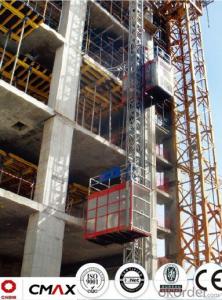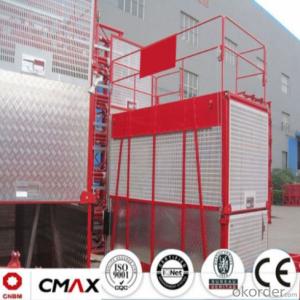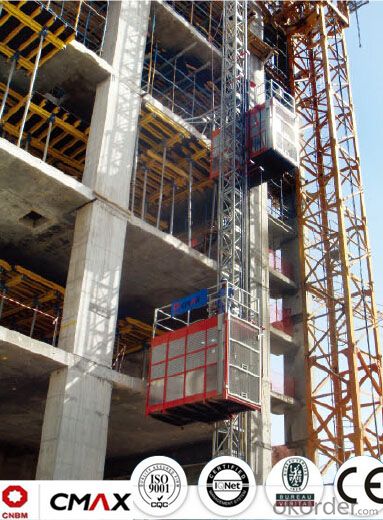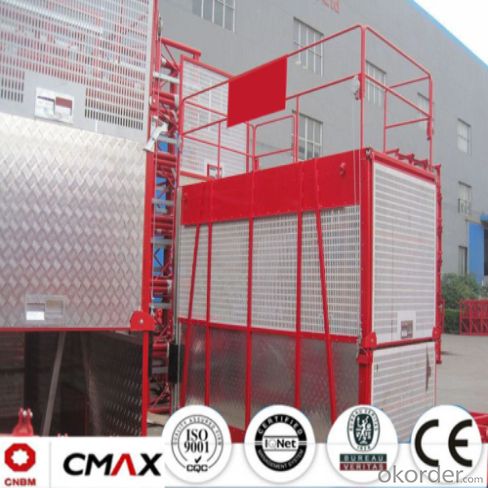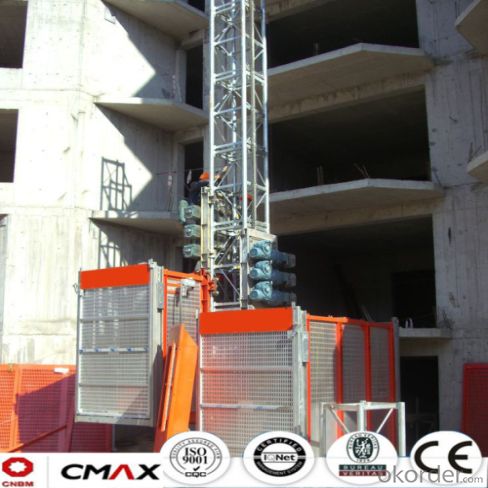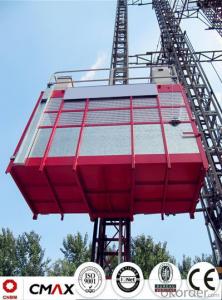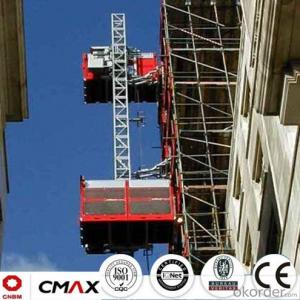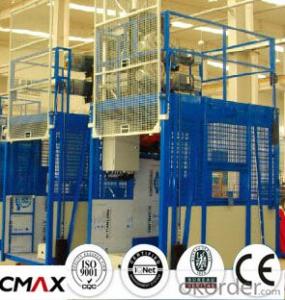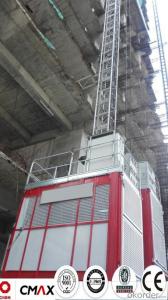Building Hoist Mast Section Manufacturer with 6ton
- Loading Port:
- China main port
- Payment Terms:
- TT OR LC
- Min Order Qty:
- 1 unit
- Supply Capability:
- 5 unit/month
OKorder Service Pledge
OKorder Financial Service
You Might Also Like
Structure of Building Hoist Description
1.The gearing select perfect bearing,strong cables and oil seal.
2.The electrical parts select products from famous world manufacturers for example Schneider,Siemens and LG.
3.The racks and pinion select advanced material and advanced technique,which enhance the life of all parts.
4.The steel structure adopted strong steel from famous native manufacturers.
5.The surface of the steel structure can adopt paint-spray,parkerizing baking finish or hot galvanizing processing depending on users requirement.
6.The cage can be made and decorated by aluminum molded board,punched-plate or figured aluminum board.
Packaging & Delivery of Building Hoist
Packaging: nude and wooded box Delivery: 25-30days
Mains Parts of Building Hoist
1.The steel structure for example the mast, tie in and cabin ,could be all spay-painted and hot galvanized. Mast section is made with high quality Q345B which is the top standared in China.
2.Electrical parts are all adopted with Schneider , Siemens and other famous brands.
3.The electrical system can be selected with the normal control method and VVVF+PLC control way. Inverter we selected is from Schneider. Yaskawa or other world renowned brand.
4.Cabin exit door select ramping type. The ramping door looks like a bridge between the construction hoist and construction building.
5.The cabin floor is made from 3MM thickness steel riffled board(Hot dip galvanized), and 15MM thickness wooden board which can reduce the vibration and deformation a lot.
6.Driving unit is adopted the products from ZHANGJIANG and other reputed maker, or from SEW, NORD.
7.Safety system is mainly composed of electrical motor braking, anti-drop safety device, top & bottom limit switches, top & bottom 3-phase switches, door limit switches, buffer device and over-load protection. The system aims to ensure the hoist are running safely.
8.Qualification: CE, ISO9001:2008 and etc.
9.The long-term operation of CMAX building hoists testifies CMAX hoist is working performance is stable.
Building Hoist Images



Building Hoist Specification

FAQ of Building Hosit
Q: What is the building hoist main purpose?
A: Building hoist equipped with double or single cabin to transport the materials and labors up and down. It's the ideal construction equipment for vertical transportation in the field of construction.
Q: What is the main structure of building hoist?
A: The P/M construction hoist mainly contains metal structure, driving system, electrical control system, cable guide & protection system, electrical top crane and safety device.
Q: What is the meaning of the building hoist’s code?
A: Take SC200/200 for example: “SC” stands for rack and pinion hoist, “200/200” stands for double cage and capacity is 2 tons per cage. “SC200” stands for single cage and capacity is 2 tons.
Q: What is the dimension of the cage?
A: Normally the cage dimension is 3X1.5X2.5M (L/W/H) for 2t type hoist. Details should be checked according to our
quotation sheet. Also, the size can be customized according to the factual site condition. There are two doors (entrance& exit doors) for each cage, It can be produced as up & down sliding or ramping model for safety and convenience.
- Q: This question asks for a comparison between manual and automatic lifting systems used in construction equipment, highlighting their distinct features and operational differences.
- <p>Manual lifting systems in construction equipment rely on human effort to lift and move materials. They are often less expensive, require less maintenance, and are suitable for lighter loads or smaller-scale projects. However, they are labor-intensive, can be slower, and pose higher risks of injury due to the physical demands. Automatic lifting systems, on the other hand, use mechanical or electronic means to lift and move materials. They are more efficient, can handle heavier loads, and reduce the risk of injury by minimizing manual handling. These systems are often more expensive and require regular maintenance but offer precision, speed, and ease of operation, making them ideal for large-scale construction projects.</p>
- Q: This question asks for the method to determine the maximum weight that a building hoist can safely lift.
- <p>To calculate the lifting capacity of a building hoist, you need to consider several factors. First, identify the hoist's rated capacity, which is usually specified by the manufacturer. This is the maximum weight the hoist is designed to lift. Next, assess the condition of the hoist, including any wear and tear that might affect its performance. Check the hoist's mechanical components, such as cables, pulleys, and motors, to ensure they are in good working order. Additionally, consider the weight of the load you intend to lift and any additional factors like the frequency of lifts or the height of the lift. Always operate within the hoist's rated capacity and follow safety guidelines to prevent accidents.</p>
- Q: The safety officer shall be responsible for the work of the construction elevator
- (1) the use of dual-use functions of the construction elevator, the installation and removal of the professional personnel issued by the competent department of construction administration shall be undertaken by the professional personnel. The personnel who have passed the training, qualified for the examination and obtained the certificate of the post shall be operated and repaired. (2) the capacity of the concrete base culture cooperation should not be less than 150kPa, the tolerance of 10mm and the drainage facility should be allowed. The distance between the guide bracket of the elevator and the wall of the building should be suitable, and the smoothness should be stable. (3) the lifter is used to control two directions, and the vertical control is 0.05%. Each floor shall have a platform, a passage, a fence and a protective door. No obstacles can be found. (4) the elevator that is installed in a dark place, and the passage shall be illuminated and a floor display lamp and floor number; A closed barrier should be set up in the well. The elevator shall be subject to acceptance by the technical director and the relevant departments, and shall be tested by the crash and shall be used in the rear. (5) in the use of or during the use of the elevators, the manufacturer or designated unit shall conduct the debugging and maintenance and verification. The lifter should undergo a fall test every three months and the fall test should be adjusted when the fall test exceeds 1.2 m. Every time it falls, the receiver should be repaired once.
- Q: This question asks for a description of the process of operating a building hoist using a remote control system.
- <p>To use a remote control system for a building hoist, first ensure that the hoist is properly installed and inspected for safety. Turn on the hoist's power supply and ensure the remote control is synced with the hoist. Familiarize yourself with the control panel, which typically includes buttons for up, down, stop, and emergency stop. Operate the hoist by pressing the up or down buttons to lift or lower the load. Always monitor the load's movement and communicate with workers on site. Use the stop button to halt the hoist if needed, and the emergency stop button in case of an immediate hazard. Regularly check the hoist's operation and maintain the remote control system to ensure smooth and safe operation.</p>
- Q: Does the building height not exceed 40 meters must install the construction elevator?
- In the guangdong area, the first installation and acceptance of the equipment will be below 7 levels, and more than 7 floors will be charged for the inspection. Another 9 meters per wall, the most suitable installation time is a building at least 12 meters, which can be installed at 21 meters in the evening.
- Q: This question asks whether a building hoist can be utilized for lifting various kinds of objects.
- <p>Yes, a building hoist can be used for lifting multiple types of objects. It is designed to handle a variety of materials, including construction materials, tools, and equipment. The hoist's capacity and design may vary, allowing it to accommodate different weights and sizes. However, it is crucial to ensure that the hoist's lifting capacity is not exceeded and that the objects are secured properly to prevent accidents. Always refer to the manufacturer's guidelines for specific weight limits and safety procedures.</p>
- Q: Identify the elements that influence the durability and operational lifespan of lifting machinery, specifically focusing on Building Hoists.
- <p>The lifespan of lifting equipment, including Building Hoists, is influenced by several factors: 1) Material Quality: The type and quality of materials used in construction directly affect durability and resistance to wear and tear. 2) Design and Engineering: Proper design ensures optimal performance and reduces stress on components. 3) Frequency of Use: More frequent use can lead to faster wear and tear. 4) Maintenance and Repair: Regular maintenance can extend the lifespan, while neglect can shorten it. 5) Operating Conditions: Environmental factors such as temperature, humidity, and exposure to corrosive substances can impact longevity. 6) Load Capacity: Overloading can cause premature failure. 7) Compliance with Safety Standards: Adhering to safety guidelines can prevent accidents and damage. 8) Technological Advancements: Newer models may have improved features that extend lifespan.</p>
- Q: Is it possible to employ a building hoist for demolition purposes?
- <p>While a building hoist is primarily designed for construction purposes, such as lifting materials and personnel to different floors, it is not typically recommended for demolition work. Demolition requires specialized equipment that can handle the specific stresses and hazards associated with breaking down structures. Using a building hoist for demolition could be dangerous and may not comply with safety regulations. It's crucial to use equipment specifically designed for demolition tasks to ensure the safety of workers and the effectiveness of the operation.</p>
- Q: This question asks for a comparison of the benefits and drawbacks of employing lifting equipment in the construction industry.
- <p>Advantages of using lifting equipment in construction include increased efficiency, reduced manual labor, and the ability to handle heavy loads safely. It can also improve safety by reducing the risk of injury from lifting heavy objects manually. Additionally, it allows for faster construction times and can access hard-to-reach areas. Disadvantages include high initial costs for purchasing or renting the equipment, potential for mechanical failure, and the need for skilled operators. There is also a risk of accidents if the equipment is not used properly, and it may require more maintenance and training for staff.</p>
- Q: This question asks for guidance on selecting appropriate lifting equipment based on specific requirements and work conditions.
- <p>To choose the right type of lifting equipment for your specific needs and work environment, consider the following: 1. Load capacity: Ensure the equipment can handle the weight of the items you need to lift. 2. Workspace: Evaluate the size and layout of your work area to determine the appropriate size and type of equipment. 3. Safety features: Look for equipment with safety features that meet your industry's standards. 4. Mobility: Consider whether you need a mobile or stationary unit. 5. Compatibility: Ensure the equipment is compatible with other tools or machinery you use. 6. Budget: Determine your budget and find equipment that offers the best value for your investment. 7. Consult with experts: Speak with equipment manufacturers or distributors to get their recommendations based on your specific needs. Always prioritize safety and efficiency when selecting lifting equipment.</p>
Send your message to us
Building Hoist Mast Section Manufacturer with 6ton
- Loading Port:
- China main port
- Payment Terms:
- TT OR LC
- Min Order Qty:
- 1 unit
- Supply Capability:
- 5 unit/month
OKorder Service Pledge
OKorder Financial Service
Similar products
Hot products
Hot Searches
Related keywords
